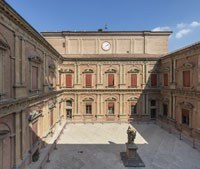
The University of Bologna is made up of 31 Departments.
There are also 7 Interdepartmental Research Centres and 11 interdepartmental research and/or training facilities.
98 libraries and facilities provide bibliographic and documentary services to support education as well as teaching, research, professional and cultural activities. The University Museum Network comprises 15 Museums and Collections dedicated to various disciplines.
96,945 students have chosen the University of Bologna (2023/24 a.y.), including 9,826 international students. A total of 1,036,109.13 square metres are allocated to curricular and extracurricular activities in the following locations: Bologna, Cesena, Forlì, Ravenna and Rimini.
3,289 international students took part in exchange programmes and 3,888 University of Bologna students spent a period of study abroad in 2023/24 a.y.
262 Degree Programmes are on offer in 2024/25 academic year, of which 104 first-cycle Degree Programmes, 144 second-cycle Degree Programmes and 14 single-cycle Degree Programmes. They include 110 international Degree Programmes, 91 of which are taught in English.
51 PhD Programmes (2023/24 a.y.), 59 Specialization Schools, and 86 first and second-level Professional Master's Programmes are also on offer.
6,843 people work at the University of Bologna, including 3,448 members of the teaching staff and 3,395 members of the professional staff.
Since January 2023, there are 11 Departments of excellence funded by the Italian Ministry of Universities and Research.
Over 370 of our research projects are funded by the EU, more than 780 received national funding and over 630 received regional and local funding.
28 projects were approved under the Italian National Recovery and Resilience Plan (NRRP).
There are 59 active and accredited spin-offs and start-ups and there are 800 registered patents, software and vegetable varieties.
Update March 2025
